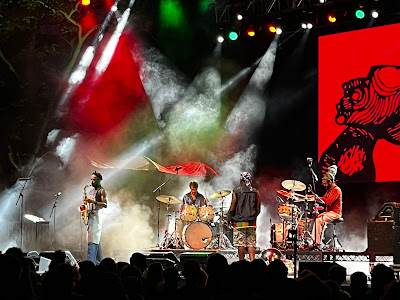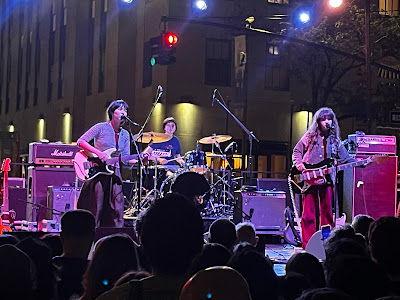As the leaves began to turn and rain down, a veritable flood of albums of all genres were released, from newcomers and veterans alike. This deluge held music of such quality that even if all music of the previous nine months mysteriously disappeared, we could call it a damned fine year. Thank goodness that didn't happen, but I can say that my calculations for those year-end lists have been upended in the last few weeks. A few of the reasons why can be found below and in a subsequent post or posts.
Follow along in this playlist or below.
John Luther Adams - Sila: The Breath Of The World Though composed for very different forces (woodwinds, brass, percussion, strings, and voices vs. symphony orchestra), as an experience Sila takes its place alongside Become Ocean and Become Desert: a seemingly vast expanse of music that unfolds more like landscape than anything else. Behind the scenes, there are other differences, with each player given the chance to be "a soloist, who plays or sings a unique part at her or his own pace," creating a bespoke version of the work each time it's performed. Here, the players are the JACK Quartet, the Crossing Choir, and musicians from the University of Michigan, all artists of such surpassing excellence that every minute lands with the inevitability of the tides. Given the flexibility granted to the performers, it may be surprising how completely unified the sound is, with instruments and voices blending together in a sublime wash of sound that invites to you to pause, to breathe, the find your own rhythm among theirs. Sila takes its name from the Inuit spirit that animates all things and, even though it preserves a particular performance forever, this remarkable recording feels marvelously alive.
Anthony Cheung - Music For Film, Sculpture, And Captions Listening to this spine-tingling collection of three pieces puts you in dialog with a lively mind as it responds to creativity encountered in sculpture, film, and, yes, captions. Cheung's absolute brilliance as an orchestrator and sonic synthesist are at the fore throughout, perhaps most impressively in The Natural Word (2019), composed for and performed by Ensemble dal Niente. Inspired by a selection of closed-captions describing sounds other than dialog, this gives Cheung the opportunity to blend together, in a witty and captivating 15 minutes, such cues as "orchestra playing tender melody" and "rain pattering." The assured architecture of the piece - another specialty of Cheung's - keeps it from being just a sequential series of sounds. That structural confidence is also well-represented in A Line Can Go Anywhere (2019), a piano concerto that pays homage to the spare, playful beauty of Ruth Asawa's sculpture. Pianist Ueli Wiget and Ensemble Modern give a dazzling, definitive performance of a work which could find a place in any orchestra's repertoire.
Null And Void (2019), given a swaggering, pin-sharp performance by Ensemble Musikfabrik is not a film score but a "musical analogue" for Guy Maddin, Evan Johnson, and Galen Johnson's silent short, Stump The Guesser. Not having seen it, I can only say that if the film is as full of charm, elegance, and emotional variety as the music Cheung created, it must be a masterpiece. Cheung's music for smaller forces is well represented on All Roads, released earlier this year. Most notable is the title piece, for string quartet and piano, which absorbs harmonic language from Billy Strayhorn's Lotus Blossom with graceful results. All in all, a banner year for Cheung fans, a constituency which should be growing rapidly!
Julian Brink - Utility Music Like Brink, I am a fan of Jonny Greenwood's film scores. Unlike Brink, I did not move halfway around the world (from South Africa) to get a master's degree in film composition from Berklee. A move to California had him putting that degree to use and scoring several indie films, including Amir Motlagh's Three Worlds (2018). But what we have here is repurposed music from one that got away, 11 short pieces that show not only an individual approach to scoring (Eventually Lapse, for example, combines a string quartet with trumpet, harp, and guitar), but a very organic sense of building harmonies and melodies into emotion-evoking snapshots. The sense of unity among the players is a further tribute to his skills as the players recorded in five different cities and were blended together later. Brink's music is sure to enhance your life, however you make use of it.
Andrew McIntosh - Little Jimmy I admit to being slightly distracted by the title of the main piece (2020) here, which is named after a campground in a National Forest in California. In no way does it prepare you for the thoughtful, suspended sounds to come, with the piano/percussion quartet Yarn/Wire, dropping jewel-toned sounds and repeating phrases into a space colored by field recordings from the campground. Knowing the campground was forever changed by the raging Bobcat Fire also lends emotional resonance, but the music is very evocative either way. Two other pieces, I Have A Lot To Learn (2019), a gently spiky piano piece, and Learning (2021), a meditation for solo percussion, fill out what makes for an excellent introduction to McIntosh's work.
Greg Stuart - Subtractions As a collaborator with some of the most distinctive composers of our age, such Sarah Hennies and Michael Pisaro-Liu, both of whom have works premiered on this album, Stuart has more than staked a claim for himself on the landscape of avant garde percussion. Throw in work with Clipping, the radical hip hop group, and the picture broadens to a musician of uncommon depth. No surprise that he tosses off the nervous assemblage of Hennies' Border Loss (2021) as if he thought of it on the spot. His lightness of touch astonishes even more when you learn of his focal dystonia, a condition which leaves his left hand unpredictable and even uncontrollable. But any difficulty he might have is rendered completely invisible here and in Pisaro-Liu's Side By Side (2021). The first movement, for bass drum and cymbals, is exquisitely tactile, a study in texture and almost a deliberate avoidance of rhythm. Part two, for vibraphone and glockenspiel, exploits the attack and sustain of each instrument beautifully, gleaming streaks of sound hanging in the air. Let them decorate the space around you.
Stephen Vitiello and Bill Seaman - The Other Forgotten Letters Over the last four years, we have been graced with many riches in the realms of ambient and electronic music from Vitiello. While I have always found his sound art fascinating, I am even more heartened by the stand-alone music he has been releasing, of which this is one of the most accessible. A long distance collaboration with Seaman, also a sound and visual artist, the three pieces here are immersive and cinematic, with a temporal inevitability that belies the improvised origins of much of the music. A hall of memories, a landscape through rain-streaked glass, a tense film montage...close your eyes and let the guitars, pianos, synths, and percussion of Vitiello and Seaman work their magic. Much to my delight, the duo promises more is yet to come later this year. Don't get left behind.
Seabuckthorn - Of No Such Place Both ethereal and dramatic, like a gritty but gorgeous film about survival, Andy Cartwright's latest under this moniker is one of his best. The guitar, treated and prepared, is always at the heart of these records, but once combined with field recordings, clarinet, tongue drum, and cymbals, it becomes almost immaterial. That said, Form Less Ness, an album he released earlier this year under his own name with only "a little obscured guitar," drifted far enough from shore that I could never be certain I actually heard it. Of No Such Place sticks with you.
Brian Eno - FOREVERANDEVERNOMORE "I think Eno has ascended to another plane," I said to my wife as we listened to this in jaw-dropped stillness. She agreed, marveling at the warm embrace of his deeper but still characteristic voice, mostly unheard since 2005, surrounded by gloriously rich textures. My statement had a double meaning, too, both referring to the utter majesty of the music and to the sense of godlike remove he was projecting across these 10 tracks. That was even before I read his statement that "I like creating worlds, that’s what I do as an artist, creating sonic worlds." Adding his voice, according to him, is like peopling his landscapes with humans. From on high, he's noting that our home planet has been much abused and we need to fall back in love with nature and appreciate all it gives to us. So, a climate change record, if you must. But you don't have to. It may just be enough to recognize that a world that gifts us Eno and his all-encompassing reinvention of drone-based song, just may be a world worth holding onto.
Molly Joyce - Perspective In writing about her last album, 2020's Breaking And Entering, I said of one song that it puts "wind in your hair as you pirouette through the ether in imagined flight." That sense of weightlessness, and of an artist coming into her own, made for a thrilling listen, and must have been equally thrilling for Joyce - who also identifies as a disability activist - to put into the world. On Perspective, you get a 360 view of what she was working against when cutting loose the bounds of the earth on Breaking And Entering. Each track features a variety of voices answering questions relating to their experience of disability: What does: access, control, care, weakness, strength, etc. mean to you? Listening to the answers is alternately sobering and inspiring and, yes, lends new perspective on how people with disabilities - like, say, my brother-in-law, blinded by retinitis pigmentosa - are forced to navigate the world. But even those of us without a disability but who have been confronted by the hardest tests life can throw at you can relate to much of this, as when the one speaker answers "What does resilience mean to you?" with "It's a never give in feeling." The music behind all these unvarnished sentiments is not unlike what we heard on Breaking And Entering: pulsing, looping electronics, sometimes with percussive elements, sparkling and full of forward motion. Joyce gives these brave speakers extra dignity by setting their thoughts in these exquisite frames.
Corntuth - Letters To My Robot Son On his third album, the artist currently known as Corntuth, has pursued the programmatic nature of his music even beyond that of his first album, the self-explanatory Music To Work To, or his second, the impressionistic road trip of The Desert Is Paper Thin, into pure storytelling. The background he imagines for this album, created with his trademark vintage digital synths, involves a series of musical modules left by one of the last humans for his robot son, in the hopes that they might act as software and make him sentient. That series of sci fi thoughts leads to sounds that have the bright naiveté of early Bill Nelson solo electronica, like La Belle Et La Bête, alongside the soulful sensibility that has defined Corntuth's music from the start. A perfect example is E-003, which pairs a chilly repeating loop with some warmer and perfectly placed chords in a contrasting and wonderfully fat texture. One knock against the Yamaha DX7 when it first came out was that it took some of the creativity out of synthesis with a plethora of preprogrammed sounds. Perhaps like the robot son, the DX7 and Korg Poly-800 mkII, were just waiting for the right spirit to bring their ultimate humanity to the fore, which is exactly what Corntuth does on this enchanting album.
You may also enjoy:
Record Roundup: Catching Up (Sort Of)
Record Roundup: Fall Classics, Vol. 1
Record Roundup: Fall Classics, Vol. 2
Listening To Lux On West 57th




























